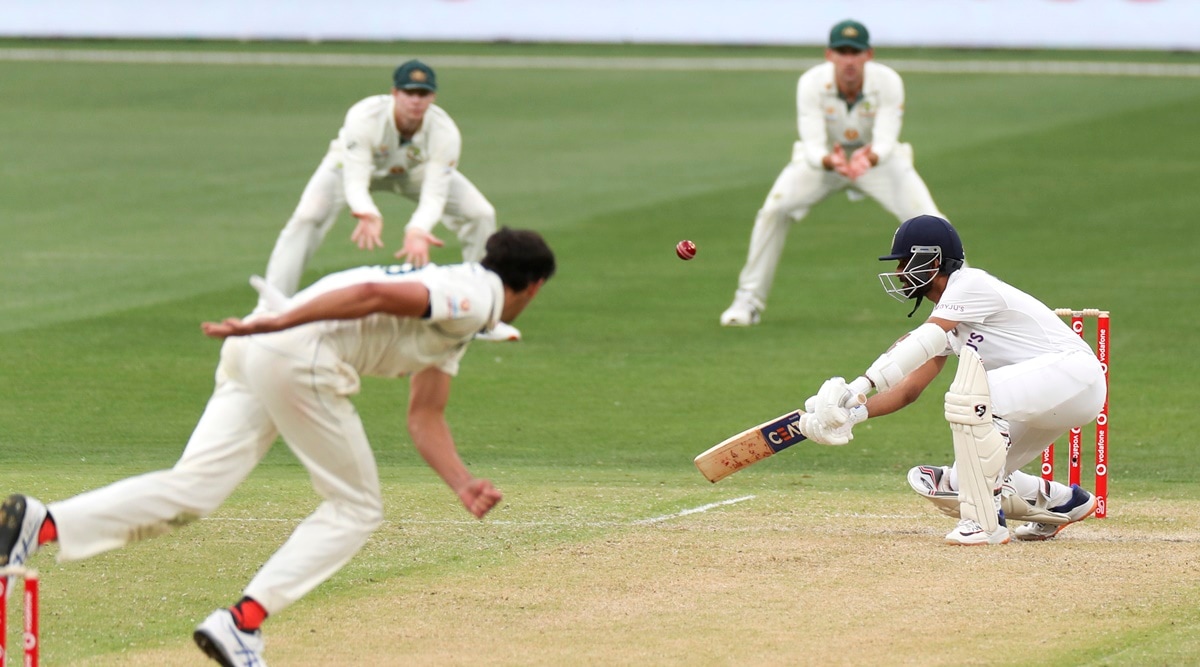Even Rahane, in this character-defining knock, didn’t exactly start taking big steps, until very late in his knock.
Barring Virat Kohli, none of the Indians who made their Test debuts after 2010 have a decent forward stride as part of their defensive oeuvre. At some point, the Indians have mysteriously shed that movement. It’s as if they didn’t grow up watching Rahul Dravid, who would stretch forward inexorably, or Sachin Tendulkar, who would make a precise forward movement.
Some like Rohit Sharma or Rishabh Pant, and to an extent Ajinkya Rahane, have it in them to move forward to attack, but they don’t. On his day, which is yet to come this series, Cheteshwar Pujara does defend or attack off the front foot but he isn’t part of this post-’10 generation, anyway. Collectively this lot, have all started to pitch their tent at their original stance, and rarely ever budge too much.
For most of this decade, ‘holding shape’ has been the buzzword on the white-ball circuit. Players are told to have wide stances since it will help them maintain balance as they try to hit most balls out of the park. When you are lining up for the ball and swinging through the line, ‘holding shape’ becomes vital. It’s a principle borrowed from golf. Batters teeing off is a sign of cricket’s golfisation. In this single-minded pursuit of ‘holding shape’ while having a ‘wider stance’, the finer nuances of classical batsmanship – ‘weight transfer’ and ‘forward stride’ – have been largely forgotten.
Over reliance on ‘hands’ too has resulted in Indian batsmen getting leaden-footed. Raised in Indian conditions, on mostly slow tracks, they feel they can get out of trouble as they have time to use their hands and adjust. They can let their hands wander beyond their tiny footsteps to tackle the little deviations of the ball.
Even Rahane, in this character-defining knock, didn’t exactly start taking big steps, until very late in his knock. But what he did differently from Adelaide was with his hands; he let them move ahead of his pads and started to meet the ball in front of his body. He would also occasionally stand outside his crease, especially to Josh Hazlewood.
In Adelaide, he rarely met the ball ahead of the front pad. Here, the front foot did move out a little bit more than it did in the first Test. The movement was first spotted in the 19th ball he faced, off Hazlewood, when the front leg came out marginally. Twice in a row, and an alert Hazlewood banged the next two balls short to try pushing him back. Rahane didn’t abandon that short forward press, though, as it allowed him to get his upper body to lean forward, and let his hands come through ahead of the front pad, the crucial reason for his success this time.
Pujara was out to a familiar dismissal, seen not just in Adelaide but in the past as well. When the ball lands short of length around the off-stump and straightens, he tends to open up. He takes a short step forward and tries to hold his balance there. It’s a difficult task as in this process, his hips open up. The good thing is that invariably he manages to hold his bat inside the line or sponge it with soft hands so that edges don’t carry. But then someone like Pat Cummins comes along who has specialised in not cutting the ball away, but holding its line to induce a nick that carries.
Pujara’s short step isn’t the problem, it’s what he does after that. Unlike Kane Williamson, who looks to get forward with a small press – much like Pujara – but then that step is just the start of Williamson’s negotiations. Not the end. “From that forward press, depending on the length, Kane either pushes back or gets forward further,” Williamson’s long-time coach David Johnston says. “He doesn’t allow the bowler to dictate lengths by being crease-bound.” Pujara used to do that, of course, but isn’t doing so now.
Source: Read Full Article


